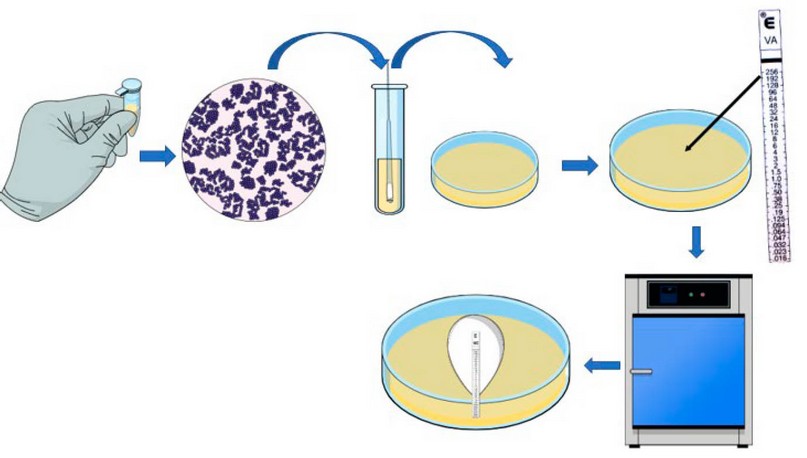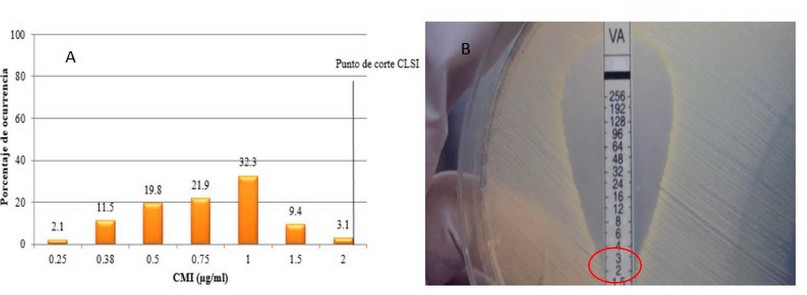2023.08.03.35
Files > Volume 8 > Vol 8 No 3 2023
Study of susceptibility to vancomycin from clinical isolates of Staphylococcus aureus
1 Microbiological Research Institute (IIM), National Autonomous University of Honduras (UNAH), Tegucigalpa, Honduras; [email protected] (LS); [email protected] (LE)
2 Institute for Research in Applied Sciences and Technology (IICAT), National Autonomous University of Honduras (UNAH), Tegucigalpa, Honduras; [email protected]. (LS)
3 Facultad de Microbiología (FMic) y Centro de Investigación en Enfermedades Tropicales (CIET), Universidad de Costa Rica (UCR), San José, Costa Rica; [email protected] (NR)
4 Departamento de Química, Universidad Técnica Particular de Loja, Loja 1101608, Ecuador. LCE; [email protected],
* Correspondence: [email protected] (NR)
Available from: http://dx.doi.org/10.21931/RB/2023.08.03.35
Mr. editor
Vancomycin has been considered for over 40 years as the primary treatment option for Methicillin-Resistant Staphylococcus aureus (MRSA) strains. However, excessive, indiscriminate, or inappropriate use has led to the appearance of MRSA strains with intermediate resistance (VISA) and total resistance to vancomycin (VRSA) 1. In Central America, particularly in Honduras, no VRSA strains have been reported. However, it is vitally important to implement an epidemiological surveillance program where this isolation can be traced since its appearance has been considered a severe public health problem in the last two decades 2. By 2002, the first two VRSA strains were isolated, specifically in Michigan and Pennsylvania. Since then, a total of 52 VRSA isolates have been reported worldwide. The only country in Latin America that has reported VRSA strains is Brazil3. In this sense, we have carried out an assay to determine the MIC of the 96 clinical isolates of S.aureus obtained from patients who attended two of the essential hospital centers in Tegucigalpa, Honduras: the Hospital Escuela (HE) and the Honduran Institute of Social Security (IHSS). The samples were the same with which we studied resistance to methicillin, and it is a follow-up to the study that was previously published in this journal4. The MIC of S. aureus to vancomycin was determined using the E-test® strips (Solna, Sweden) under the same conditions reported in the previous study4 and based on what is recommended by the CLSI5 (figure 1). The cohort points to determine the susceptibility and resistance of S.aures to vancomycin can be seen in Table 1.

Table 1. Cohort points for the interpretation of susceptibility/resistance to vancomycin.

Figure 1. Schematic procedure for the detection of the MIC of S. aureus by vancomycin.
Of the 96 clinical isolates of S. aureus, none showed a MIC greater than 2 µg/mL, so we considered them all susceptible to vancomycin (SVSA). However, 3 isolates showed a MIC of 2 µg/mL right at the cohort point or the upper limit allowed by the CLSI. To make sure of these values, we repeated the test using the Vitek-2 technique. The distribution of the isolates can be seen in Figure 2A. 50% showed a MIC ≤ 0.75 µg/mL (MIC50) and 90% a MIC ≤ 1.5 µg/mL (MIC90). Figure 2B shows the S.aureus plaque with the vancomycin E-test® strip marking a halo at 2 µg/mL.

Figure 2. A. Percentage of occurrence and MIC of clinical isolates of S. aureus to vancomycin. B. MIC of 2 µg/mL to vancomycin of one of the three clinical isolates of S. aureus.
Although neither VISA nor SARV strains were found, the 3 isolates with MICs of 2 µg/mL are of concern since VISA strains could arise from heterogeneous intermediate resistance or VISAh strains. According to the literature, VISAh strains present MICs below 2 µg/mL, as found in our trials, which could lead to this phenomenon6. These findings coincide with several studies where it has been found that 30% to 50% of the S. aureus isolates had a vancomycin MIC of 2 µg/mL and that present heterogeneous intermediate resistance6,7. However, confirming the results with other official techniques was impossible since they were costly and difficult to implement. The reference test analyzes the population profile of the area under the curve (PAP-AUC), using increasing concentrations of antibiotics8,9. However, an alternative method for detecting these strains is E-test GRD, which consists of a double strip of increasing concentrations of vancomycin and teicoplanin, which is cheaper8.
Similarly, several authors who have studied the relationship between the vancomycin MIC of S. aureus strains and the efficacy of treatment with this drug have reported that when the MIC increases from 0.5 to 2 µg/mL, the chances of therapeutic failure. However, the strains continue to be classified as susceptible. Therefore, a vancomycin MIC of 2 µg/mL is a poor predictor of response to vancomycin therapy10.
In this context, we could be in the presence of VISAh strains, so more specific studies are required to confirm it. For this reason, we recommend reducing the indiscriminate use of vancomycin in these hospitals, as well as the active participation of medical, pharmaceutical, and clinical laboratory personnel in the implementation of the necessary methods for the identification and permanent monitoring of strains with reduced susceptibility to vancomycin. as well as the generation and application of a comprehensive epidemiological surveillance program.
Author Contribution: Conceptualization, LS, and NR; Methodology, LS, LE, and LCE. Data analysis, LS and NR; Validation of assays, LE and LCE; writing, proofreading, and editing, LS, NR, LE and LCE; Supervision, LE and NR. Project management, NR, and LE. All authors have read and approved the publication of this manuscript.
Acknowledgments: We thank the UNAH Master of Infectious and Zoonotic Diseases and the FMic and CIET Bacteriology Laboratory for financing the tests carried out. To the HE and IHSS in Tegucigalpa for the donation of the clinical isolates.
Conflicts of interest: The authors declare no conflicts of interest.
REFERENCES
1. Appelbaum PC. The emergence of vancomycin-intermediate and vancomycin-resistant Staphylococcus aureus. Clin Microbiol Infect, 2006;12:16-23.
2. McGuinness WA, Malachowa N., DeLeo FR. Resistencia a la vancomicina en Staphylococcus aureus. Yale J Biol Med. 2017; 90 (2): 269–281.
3. Cong Y, Yang S, Rao X. Vancomycin-resistant Staphylococcus aureus infections: A review of case updating and clinical features. J Adv Res. 2019, 12;21:169-176.
4. Sosa L, Espinoza L C, Marcia Fuentes J, Enríquez de Madrid M L, Rojas Campos N. Caracterización fenotípica y molecular de aislamientos clínicos de staphylococcus aureus resistentes a meticilina obtenidos de dos centros hospitalarios de Tegucigalpa, Hondura. Revis Bionatura, 2022;7(3) 55.
5. Clinical and Laboratory Standards Institute (CLSI). Document M38 A2. Wayne, PA: Clinical and Laboratory Standards Institute; 2022.
6. Horne KC HB, Grabsch EA, Graham M, Ward PD, Xie S, Mayall BC, Johnson PDR, and Grayson ML Prospective comparison of the clinical impact of heterogeneous vancomycin-intermediate methicillin-resistant Staphylococcus aureus (MRSA) and vancomycin-susceptible MRSA. Antimicrob Agents Chemother, 2009, 53:3447-3452.
7. Musta AC Rk, Shemes S, Chase P, Jose J, Johnson LB, and Khatib R. Vancomycin MIC plus heteroresistance and the outcome of methicillin-resistant Staphylococcus aureus bacteremia: trends over 11 years. J. Clin. Microbiol., 2009, 47:1640-1644.
8. Leonard SN RK, Newton KL, Rybak MJ. Evaluation of the Etest GRD for detecting Staphylococcus aureus with reduced susceptibility to glycopeptides. J. Antimicrob. Chemother., 2009, 63:489-492.
9. Wootton M HR, Hillman R, Walsh TR, Bennett PM, and MacGowan AP. A modified population analysis profile (PAP) method to detect hetero-resistance to vancomycin in Staphylococcus aureus in a UK hospital. J Antimicrob Chemother, 2001, 47:399- 403.
10. Howden B.P., Davies J.K., Johnson P.D., Stinear T.P., Grayson M.L. Reduced vancomycin susceptibility in Staphylococcus aureus, including vancomycin-intermediate and heterogeneous vancomycin-intermediate strains: resistance mechanisms, laboratory detection, and clinical implications. Clin Microbiol Rev. 2010;23(1):99–139.
Received: 20 June 2023/ Accepted: 25 August 2023 / Published:15 September 2023
Citation: Sosa L, Enríquez L, Rojas N, Espinoza L C. Study of susceptibility to vancomycin from clinical isolates of Staphylococcus aureusRevis Bionatura 2023;8 (3) 35. http://dx.doi.org/10.21931/RB/2023.08.03.35
